Omp 算法
% 1-D 信号压缩传感的实现(正交匹配追踪法 Orthogonal Matching Pursuit)
% 测量数 M>=K*log(N/K),K 是稀疏度,N 信号长度,可以近乎完全重构
% 编程人--香港大学电子工程系 沙威 Email: wsha@eee.hku.hk
% 编程时间:2008 年 11 月 18 日
% 文档下载: http://www.eee.hku.hk/~wsha/Freecode/freecode.htm
% 参考文献:Joel A. Tropp and Anna C. Gilbert
% Signal Recovery From Random Measurements Via Orthogonal Matching
% Pursuit,IEEE TRANSACTIONS ON INFORMATION THEORY, VOL. 53, NO. 12,
% DECEMBER 2007.
clc;clear
%% 1. 时域测试信号生成
% 稀疏度(做 FFT 可以看出来)
K=7;
% 信号长度
N=256;
% 测量数(M>=K*log(N/K),至少 40,但有出错的概率)
M=64;
% 信号频率 1
f1=50;
% 信号频率 2
f2=100;
% 信号频率 3
f3=200;
% 信号频率 4
f4=400;
fs=800;
% 采样频率
ts=1/fs; % 采样间隔
Ts=1:N;
% 采样序列
x=0.3*cos(2*pi*f1*Ts*ts)+0.6*cos(2*pi*f2*Ts*ts)+0.1*cos(2*pi*f3*Ts*ts)+0.9*cos(2*pi*f4*Ts*ts)
; % 完整信号
%% 2. 时域信号压缩传感
Phi=randn(M,N);
s=Phi*x.';
% 测量矩阵(高斯分布白噪声)
% 获得线性测量
%% 3. 正交匹配追踪法重构信号(本质上是 L_1 范数最优化问题)
m=2*K;
Psi=fft(eye(N,N))/sqrt(N);
T=Phi*Psi';
矩阵)
% 傅里叶正变换矩阵
% 算法迭代次数(m>=K)
% 恢复矩阵(测量矩阵*正交反变换
hat_y=zeros(1,N);
Aug_t=[];
r_n=s;
for times=1:m;
代次数为 K)
for col=1:N;
% 待重构的谱域(变换域)向量
% 增量矩阵(初始值为空矩阵)
% 残差值
% 迭代次数(有噪声的情况下,该迭
% 恢复矩阵的所有列向量
�
product(col)=abs(T(:,col)'*r_n);
% 恢复矩阵的列向量和残差的投影系数
(内积值)
end
[val,pos]=max(product);
Aug_t=[Aug_t,T(:,pos)];
T(:,pos)=zeros(M,1);
为了简单我把它置零)
% 最大投影系数对应的位置
% 矩阵扩充
% 选中的列置零(实质上应该去掉,
aug_y=(Aug_t'*Aug_t)^(-1)*Aug_t'*s;
r_n=s-Aug_t*aug_y;
pos_array(times)=pos;
% 最小二乘,使残差最小
% 残差
% 纪录最大投影系数的位置
end
hat_y(pos_array)=aug_y;
hat_x=real(Psi'*hat_y.');
%% 4. 恢复信号和原始信号对比
figure(1);
hold on;
plot(hat_x,'k.-')
plot(x,'r')
legend('Recovery','Original')
norm(hat_x.'-x)/norm(x)
% 重构的谱域向量
% 做逆傅里叶变换重构得到时域信号
% 重建信号
% 原始信号
% 重构误差
%A-稀疏系数矩阵
%D-字典/测量矩阵(已知)
%X-测量值矩阵(已知)
%K-稀疏度
function A=OMP(D,X,L)
[n,P]=size(X);
[n,K]=size(D);
for k=1:P
a=[];
x=X(:,k);
residual=x;%残差
indx=zeros(L,1);%索引集
for j=1:L
proj=D'*residual;%D 转置与 residual 相乘,得到与 residual 与 D 每一列的内积值
pos=find(abs(proj)==max(abs(proj)));%找到内积最大值的位置
pos=pos(1);%若最大值不止一个,取第一个
indx(j)=pos;%将这个位置存入索引集的第 j 个值
a=pinv(D(:,indx(1:j)))*x;%indx(1:j)表示第一列前 j 个元素
�
residual=x-D(:,indx(1:j))*a;
end
temp=zeros(K,1);
temp(indx)=a;
A(:,k)=temp;%只显示非零值及其位置
end
最近学习 K-SVD 算法的过程中,稀疏编码部分使用了 OMP 追踪算法,特作此总结。
求解问题:
其中 D 是过完备的字典,已经给定,Y 是原始信号,X 待求。
OMP 算法的本质思想是:以贪婪迭代的方法选择 D 的列,使得在每次迭代的过程中所选择
的列与当前冗余向量最大程度的相关,从原始信号向量中减去相关部分并反复迭代,只到迭
代次数达到稀疏度 K,停止迭代。
核心算法步骤如下:
�
相关 Matlab 代码如下:
function [A]=OMP(D,X,L);
%=============================================
% Sparse coding of a group of signals based on a given
% dictionary and specified number of atoms to use.
% ||X-DA||
% input arguments:
%
%
%
D - the dictionary (its columns MUST be normalized).
X - the signals to represent
L - the max. number of coefficients for each signal.
% output arguments:
%
A - sparse coefficient matrix.
�
%=============================================
[n,P]=size(X);
[n,K]=size(D);
for k=1:1:P,
a=[];
x=X(:,k);
%the kth signal sample
residual=x;
%initial the residual vector
indx=zeros(L,1);
%initial the index vector
%the jth iter
for j=1:1:L,
%compute the inner product
proj=D'*residual;
%find the max value and its index
[maxVal,pos]=max(abs(proj));
%store the index
pos=pos(1);
indx(j)=pos;
�
%solve the Least squares problem.
a=pinv(D(:,indx(1:j)))*x;
%compute the residual in the new dictionary
residual=x-D(:,indx(1:j))*a;
%the precision is fill our demand.
%
%
%
if sum(residual.^2) < 1e-6
break;
end
end;
temp=zeros(K,1);
temp(indx(1:j))=a;
A(:,k)=sparse(temp);
end;
return;
�
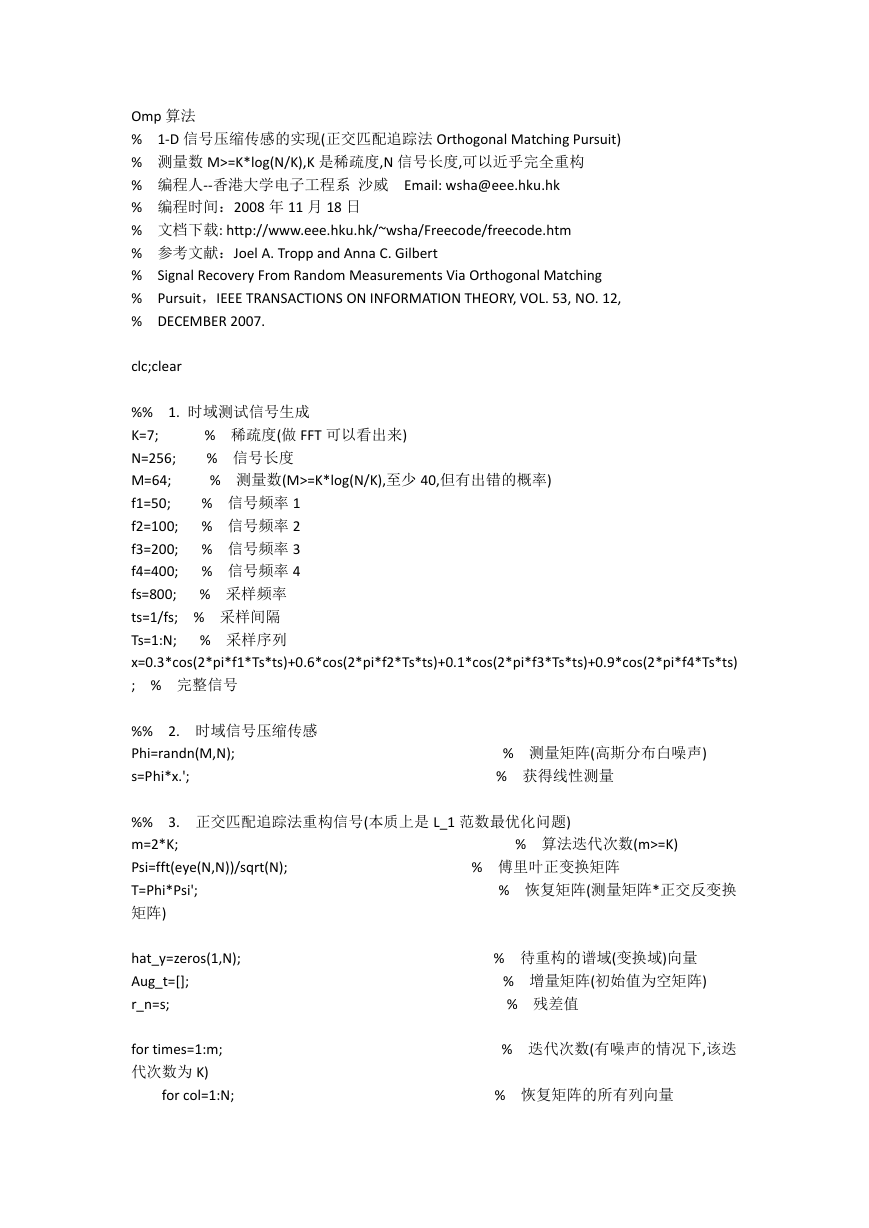
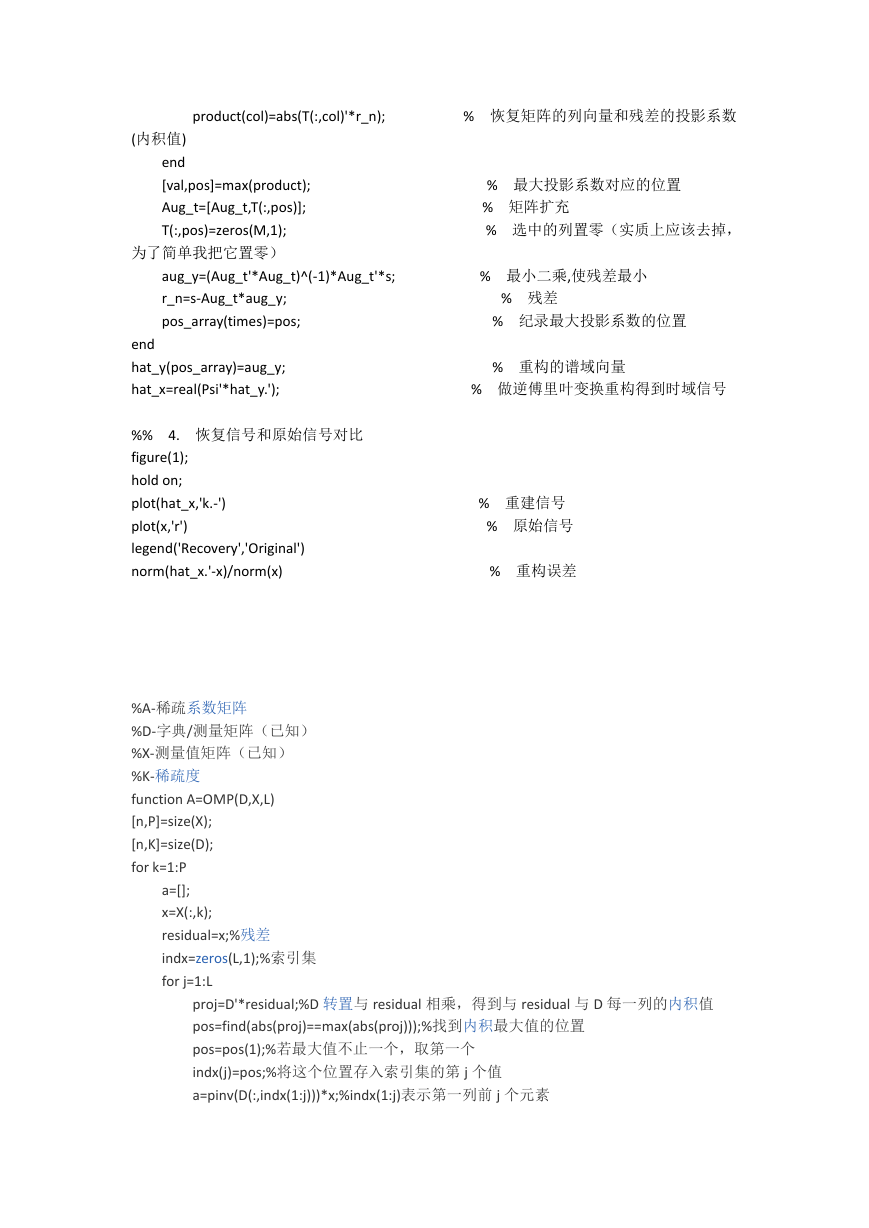
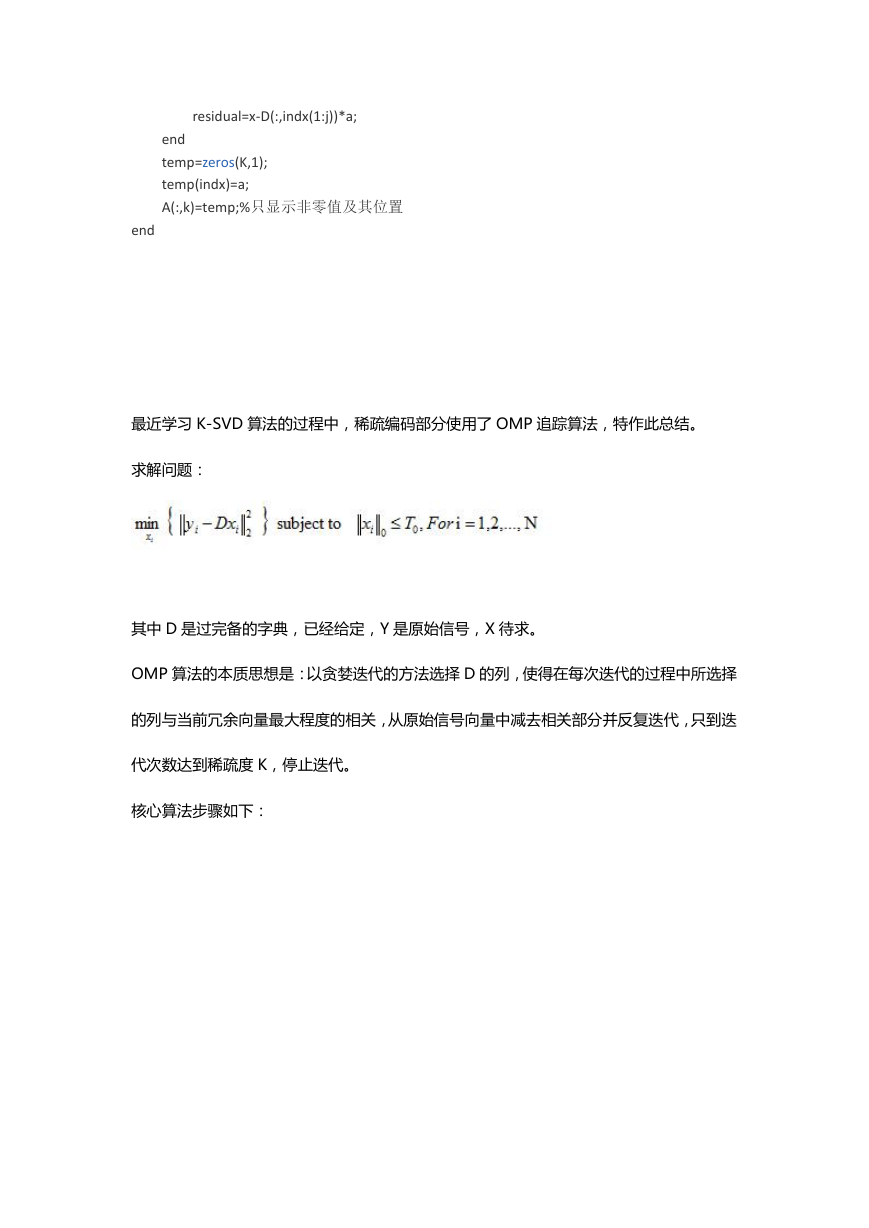
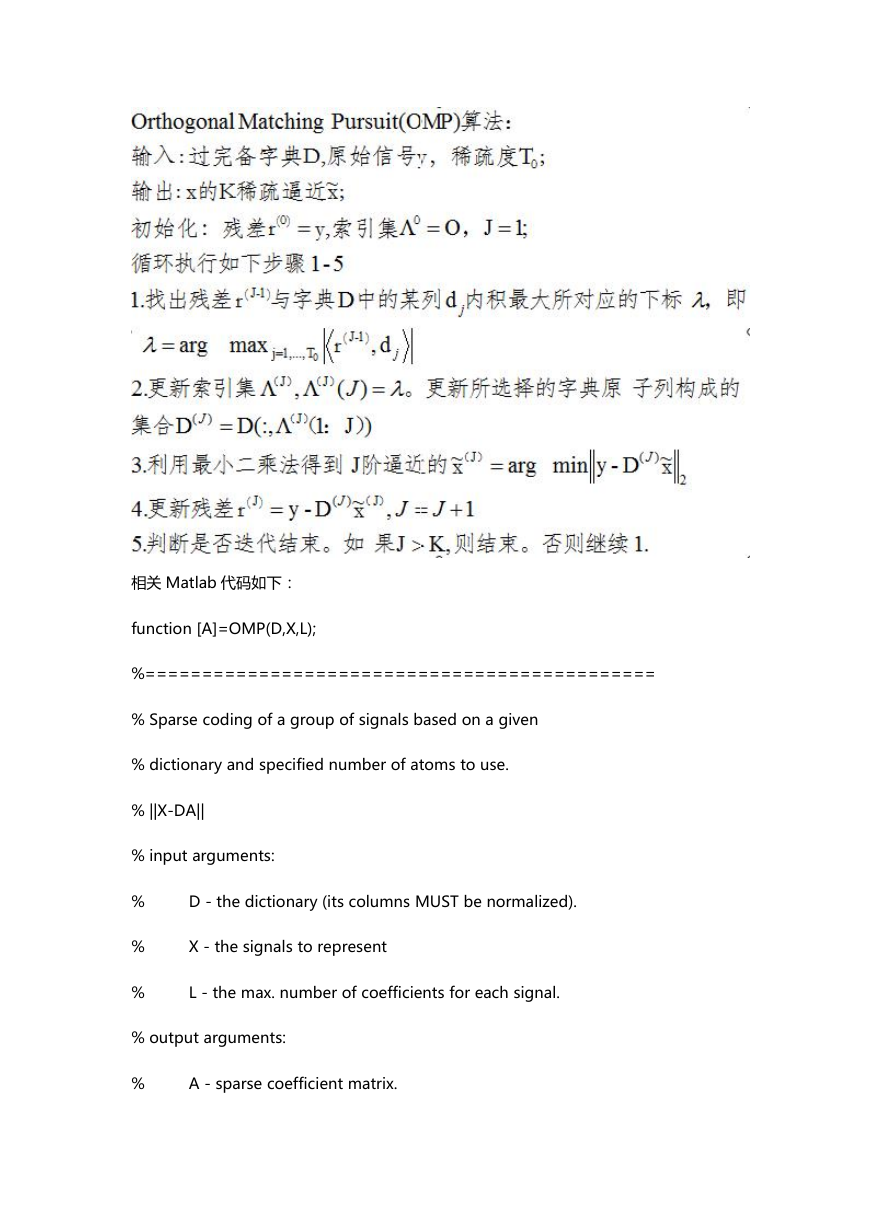
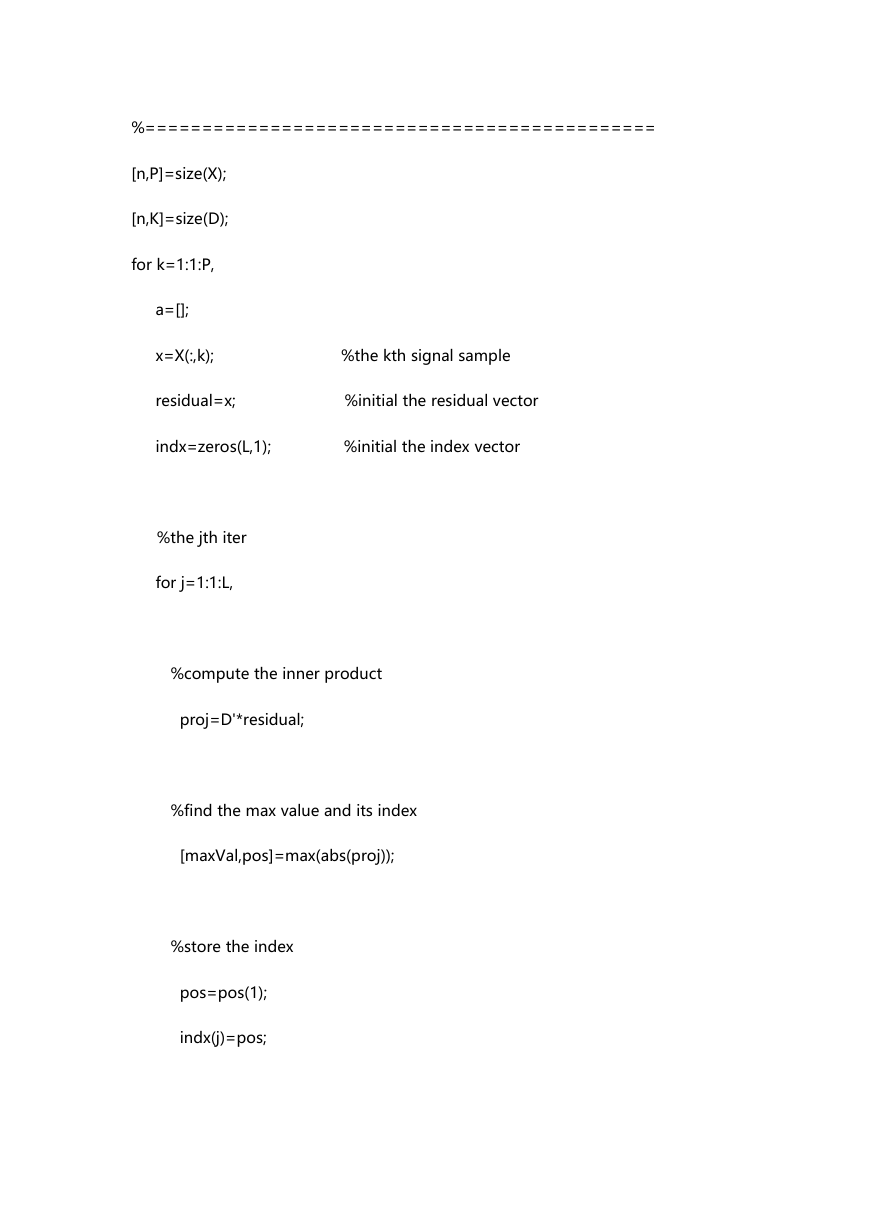
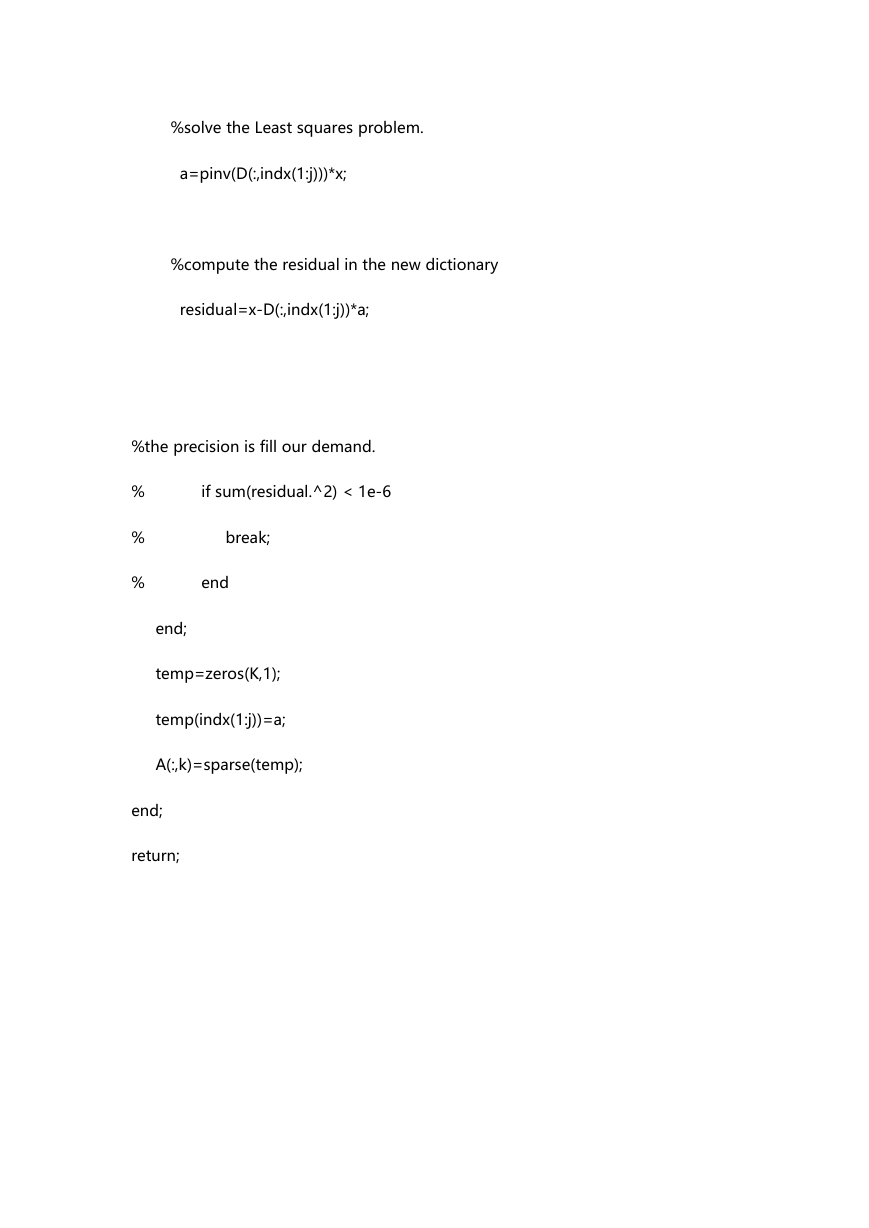






 2023年江西萍乡中考道德与法治真题及答案.doc
2023年江西萍乡中考道德与法治真题及答案.doc 2012年重庆南川中考生物真题及答案.doc
2012年重庆南川中考生物真题及答案.doc 2013年江西师范大学地理学综合及文艺理论基础考研真题.doc
2013年江西师范大学地理学综合及文艺理论基础考研真题.doc 2020年四川甘孜小升初语文真题及答案I卷.doc
2020年四川甘孜小升初语文真题及答案I卷.doc 2020年注册岩土工程师专业基础考试真题及答案.doc
2020年注册岩土工程师专业基础考试真题及答案.doc 2023-2024学年福建省厦门市九年级上学期数学月考试题及答案.doc
2023-2024学年福建省厦门市九年级上学期数学月考试题及答案.doc 2021-2022学年辽宁省沈阳市大东区九年级上学期语文期末试题及答案.doc
2021-2022学年辽宁省沈阳市大东区九年级上学期语文期末试题及答案.doc 2022-2023学年北京东城区初三第一学期物理期末试卷及答案.doc
2022-2023学年北京东城区初三第一学期物理期末试卷及答案.doc 2018上半年江西教师资格初中地理学科知识与教学能力真题及答案.doc
2018上半年江西教师资格初中地理学科知识与教学能力真题及答案.doc 2012年河北国家公务员申论考试真题及答案-省级.doc
2012年河北国家公务员申论考试真题及答案-省级.doc 2020-2021学年江苏省扬州市江都区邵樊片九年级上学期数学第一次质量检测试题及答案.doc
2020-2021学年江苏省扬州市江都区邵樊片九年级上学期数学第一次质量检测试题及答案.doc 2022下半年黑龙江教师资格证中学综合素质真题及答案.doc
2022下半年黑龙江教师资格证中学综合素质真题及答案.doc